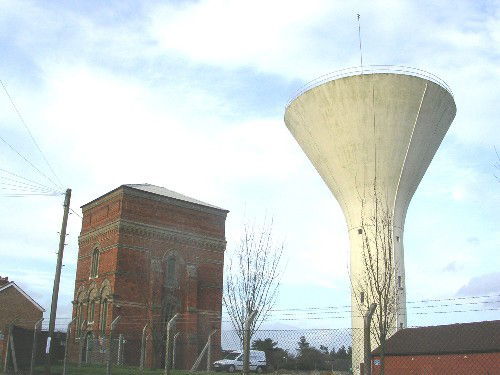 BWTAS had a enquiry today from the Eastern Daily Press asking for a quote regarding the Victorian water tower (the one on the left of the image) as an application for redevelopment into housing has been made.
BWTAS had a enquiry today from the Eastern Daily Press asking for a quote regarding the Victorian water tower (the one on the left of the image) as an application for redevelopment into housing has been made. WGS84: 52:41.2766N 0:56.7516E
For the record, BWTAS takes no position on preservation but this would be by no means the first water tower to be converted and, as long as it
was sympathetic, conversion is preferable than knocking them down.
Dereham’s Victorian tower isn't thoroughly exceptional although it does have nice Romanesque details and some lovely glazed terracotta which later towers don’t have. This is almost non-existant in Edwardian towers although they are much the same in construction. Those Victorians; things not only had to be functional, they had to be beautiful.
Last time we looked, the Dereham tower appeared intact and as it is on a waterworks site and if the EDP is looking for someone to speak up for the preservationists; historically it has proved hard to prevent redevelopment of water towers on heritage grounds because they are mostly undistinguished but in East Anglia, the stock of intact Victorian water towers is diminishing and before the very last one goes, perhaps one should be preserved to show how they work and what role they have in bringing our most vital resource to our homes. Dereham would appear to be an excellent candidate for this.
update:
BWTAS member Ferrers Young has contributed the following:
The tower at East Dereham was built in 1889, from my research, although the date of 1881 is often quoted. I believe the waterworks was built, despite a "Keep Dereham Dry" campaign - as the residents thought the scheme too expensive.
In 1881 East Dereham¹s original borehole was sunk into the chalk underlying Cemetery Road at a cost of £4,000. By 1889 treatment works had been completed together with a square brick water tower into which the treated water was pumped by a steam engine (³Dereham Past and Present², p32). Before this date, water was obtained from wells or pumps. Most properties had their own but there were three public pumps; in the Market Place near the Assembly Rooms, at the junction of London Road and Baxter¹s Row and in Washbridge (³Looking Back at Dereham, p28, 29 see folder ŒDereham¹²). Located in Cemetery Road, O.S. Grid Ref. TF 99112 14218, Capacity 30,000 gallons.
Notes: The tower appears much as it did originally, but no longer has the penthouse on top of the roof as illustrated in the ³Story of EAST DEREHAM², p66. Grade II listed on 22nd June 1984. IoE #219497.
16.10.09 Sadly the EDP has since removed this story from its website.

No comments:
Post a Comment